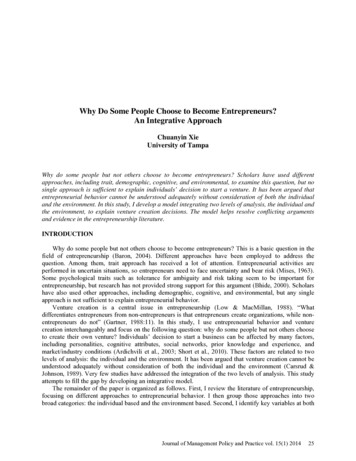
Transcription
Why Do Some People Choose to Become Entrepreneurs?An Integrative ApproachChuanyin XieUniversity of TampaWhy do some people but not others choose to become entrepreneurs? Scholars have used differentapproaches, including trait, demographic, cognitive, and environmental, to examine this question, but nosingle approach is sufficient to explain individuals’ decision to start a venture. It has been argued thatentrepreneurial behavior cannot be understood adequately without consideration of both the individualand the environment. In this study, I develop a model integrating two levels of analysis, the individual andthe environment, to explain venture creation decisions. The model helps resolve conflicting argumentsand evidence in the entrepreneurship literature.INTRODUCTIONWhy do some people but not others choose to become entrepreneurs? This is a basic question in thefield of entrepreneurship (Baron, 2004). Different approaches have been employed to address thequestion. Among them, trait approach has received a lot of attention. Entrepreneurial activities areperformed in uncertain situations, so entrepreneurs need to face uncertainty and bear risk (Mises, 1963).Some psychological traits such as tolerance for ambiguity and risk taking seem to be important forentrepreneurship, but research has not provided strong support for this argument (Bhide, 2000). Scholarshave also used other approaches, including demographic, cognitive, and environmental, but any singleapproach is not sufficient to explain entrepreneurial behavior.Venture creation is a central issue in entrepreneurship (Low & MacMillan, 1988). “Whatdifferentiates entrepreneurs from non-entrepreneurs is that entrepreneurs create organizations, while nonentrepreneurs do not” (Gartner, 1988:11). In this study, I use entrepreneurial behavior and venturecreation interchangeably and focus on the following question: why do some people but not others chooseto create their own venture? Individuals’ decision to start a business can be affected by many factors,including personalities, cognitive attributes, social networks, prior knowledge and experience, andmarket/industry conditions (Ardichvili et al., 2003; Short et al., 2010). These factors are related to twolevels of analysis: the individual and the environment. It has been argued that venture creation cannot beunderstood adequately without consideration of both the individual and the environment (Carsrud &Johnson, 1989). Very few studies have addressed the integration of the two levels of analysis. This studyattempts to fill the gap by developing an integrative model.The remainder of the paper is organized as follows. First, I review the literature of entrepreneurship,focusing on different approaches to entrepreneurial behavior. I then group those approaches into twobroad categories: the individual based and the environment based. Second, I identify key variables at bothJournal of Management Policy and Practice vol. 15(1) 201425
the individual and the environment levels. Third, I develop a framework integrating the individual and theenvironment. Finally, I discuss implications of this study and future research directions.LITERATURE REVIEWIn this section, I review different approaches used to examine entrepreneurial behavior. Based on thereview of the literature, I summarize existing research and discuss the importance of an integrativeapproach.Trait ApproachTrait approach proposes that entrepreneurship is a function of stable psychological characteristicspossessed by some people. It is the enduring human attributes that lead these people to start their ownbusiness. Considerable research has been conducted on the differences between entrepreneurs and nonentrepreneurs. For example, Hornaday (1982) identified 42 attributes possessed by entrepreneurs. Amongthose attributes, the following four are frequently cited and considered important: risk taking propensity(Brockhaus & Horowitz, 1986), need for achievement (McClelland, 1961), tolerance for ambiguity(Begley & Boyd, 1987), and internal locus of control (Brockhaus, 1982).Risk Taking PropensityVenture creation tends to involve risk, so risk-taking appears to be one of the most distinctive featurespossessed by entrepreneurs (Das & Teng, 1997). Some scholars view entrepreneurs as inherent risktakers. For example, Leibenstein (1968) argued that the entrepreneur is “the ultimate uncertainty and/orrisk bearer” (p.74). Gasse (1982) also contended that risk-taking propensity fundamentally distinguishesentrepreneurs from managers. Some empirical studies have provided support for this argument. Hull et al.(1980) reported that people were risk-taking when starting a business. Koh (1996) found that individualswith entrepreneurial inclination had a higher tendency to take risk than those with no entrepreneurialinclination.The risk-taking argument is appealing, but not all scholars agree that entrepreneurs are risk-takers.According to McClelland (1961), entrepreneurs have a moderate level of risk-taking propensity. Thereason is that they are not gambling in Las Vegas, but pursuing tasks that are achievable and controllable.Instead of deliberately pursuing risk, entrepreneurs assess and calculate risk carefully, so they are morelikely to be moderate risk takers (Cromie & O’Domoghue, 1992). They use their own skills to earn aprofit and achieve success (Cunningham & Lischeron, 1991). Miner (1990) even argued that a key task inentrepreneurship is to avoid risk.Need for AchievementNeed for achievement motivates people to engage in uncertain tasks. It is a personality trait possessedby successful entrepreneurs (McClelland, 1961) and is an important determinant for entrepreneurialactivities (Durand & Shea, 1974). There is empirical evidence that entrepreneurs have higher need forachievement than the general population (Begler & Boyd, 1987). However, it is also likely that peoplewith high need for achievement pursue other jobs such as management to achieve their goals (Cromie,2000). Hull et al. (1980) found that need for achievement was not associated with the propensity to start abusiness. Koh (1996) showed that entrepreneurs did not have higher scores in need for achievement thanmanagers.Internal Locus of ControlIf individuals do not believe in their ability to influence the outcome, they are not likely to risk theirown money to create a new business (Mueller & Thomas, 2001). It is argued, therefore, thatentrepreneurial behavior is linked to internal locus of control (e.g., Brockhaus, 1982; Perry, 1990;Shapero, 1975). This link has received support from some empirical studies. Cromie and Johns (1983)found that entrepreneurs scored higher on internal control than experienced managers; Shapero (1975)26Journal of Management Policy and Practice vol. 15(1) 2014
reported that the entrepreneur group had higher internal control than the non-entrepreneur groups.However, not all empirical studies supported the positive relationship between internal locus of controland entrepreneurial behavior. Cromie et al. (1992) found no differences in internal control betweenentrepreneurs and managers. Koh (1996) showed entrepreneurial-oriented and non-entrepreneurialoriented MBAs did not differ in internal control.Tolerance for AmbiguityTolerance for ambiguity is the willingness to act in an uncertain situation (Bhide, 2000). It has beenargued that entrepreneurs are willing to tolerate ambiguity because the activities they perform are oftenuncertain. They “eagerly undertake the unknown” and “willingly seek out and manage uncertainty”(Mitton, 1989: 15). Many people do not want to pursue a potential opportunity because of their innate orpsychological unwillingness to act in face of uncertainty (Bhide, 2000). Koh (1996) found thatindividuals who were entrepreneurially inclined had more tolerance for ambiguity than those who werenot. Tolerance for ambiguity may be important for entrepreneurship, but other factors such as skills andbackgrounds can also help individuals venture into an uncertain world (Bhide, 2000).As reviewed above, the trait approach seems appealing, but the support for “distinctive qualities” hasbeen weak or nonexistent (Bhide, 2000). When explaining the unsuccessful application of psychologicaltheories to entrepreneurship, Carsrud and Johnson (1989) presented four reasons. First, entrepreneurs areassumed to have stable characteristics, which may not be true. The environment is likely to enact achange of individuals’ attributes. Second, personality traits are not sufficient to explain specific socialbehaviors. Third, research on entrepreneurship typically separates “micro” level variables from “macro”level variables. Fourth, there is a lack of systematic research.Demographic ApproachThis approach uses individual demographic information to identify entrepreneurial behavior. It isbased on the following assumption: people with similar backgrounds possess similar characteristics(Robinson et al., 1991). Therefore, entrepreneurial behavior may be predicted by identifying the knownentrepreneurs’ characteristics such as gender, age, education, socioeconomic status, and past experiences.Though some studies suggest that men are more likely to display entrepreneurial behavior than women(Crant, 1996), gender alone cannot explain why some men or women choose to become entrepreneurs.The relationship between education and entrepreneurship is unclear. Education helps individuals gainknowledge and skills needed for venture creation, but may or may not shape entrepreneurial behavior.Souitaris et al. (2007) found education had positive impact on entrepreneurial intention. Oosterbeek et al.(2010) reported education decreased students’ intention to start a business, suggesting education mayserve as a mechanism for sorting students. The impact of socioeconomic status on entrepreneurialbehavior is not clear either. High status equips individuals with more resources, thus facilitatingentrepreneurship. Low status may motivate individuals to be their own boss in order to avoid “shame”(Goss, 2005). Bhide (2000) argued that individuals with middle-class status are more likely to start abusiness than individuals from extremely wealthy or extremely deprived backgrounds. Entrepreneurialexperience has been found to have positive impact on venture creation (Davidsson & Honig, 2003;Delmar & Davidsson, 2000), but many ventures are also created by people who have no entrepreneurialexperience.Cognitive ApproachCognitive approach focuses on the cognitive mechanisms through which individuals acquire, store,transform, and use information in the decision making process (Matlin, 2002). New ventures are oftencreated under uncertainty, so cognitive factors such as perception and interpretation of limitedinformation can play important roles in venture creation decisions (Forbes, 1999). Existing cognitiveresearch on entrepreneurship has emphasized individuals’ cognitive structures and processes (Shook etal., 2003).Journal of Management Policy and Practice vol. 15(1) 201427
Cognitive Structure ResearchA cognitive structure is a hypothetical link between a stimulus and an ensuing judgment (Bieri et al.,1966). It is associated with knowledge storage and is often represented by constructs like schema, script,or knowledge structure (Gioia & Poole, 1984; Walsh, 1995). According to Buseniz and Lau (1996),cognitive structures function as a framework for people to enact their environment. It “invokes memory,provides knowledge, specifies relationships, and produces outputs by making predictions or inferencesand initiating behavior” (p.28).Entrepreneurs may have distinctive cognitive structures that have been addressed in different ways.Mitchell et al. (2000) found that arrangements, willingness, and ability scripts were associated withventure creation decisions. Krueger and colleagues (2000) reported that perceived feasibility anddesirability had positive impact on individuals’ intention to start a new business. Existing cognitiveresearch has treated cognitive structures as being given or stable. Instead, they are experienced-based andcontext-related (Abelson, 1976). They are formed when individuals experience events in specificcontexts. They are not isolated from the environment.Attitude, another form of cognitive structure, has also received attention in entrepreneurship research.It is defined as “the predisposition to respond in a generally favorable or unfavorable manner with respectto the object of the attitude” (Robinson et al., 1991: 17). Individuals’ attitude is not seen as being stable.Instead, it changes across both time and situation through person-environment interactions. Some scholarsargued that attitude is a better indicator for entrepreneurial behavior than personal traits or demographicvariables (McCline et al., 2000; Robinson et al., 1991).Cognitive Process ResearchA cognitive process refers to the way in which information is received and utilized (Walsh, 1995).Human beings are far from totally rational, so biases often exist in the decision making process.According to Baron (2004), cognitive biases play an important role in venture creation decisions. Theyhelp entrepreneurs navigate uncertain situations, process information, and simplify decision making(Busenitz & Lau, 1996). Among various forms of cognitive biases, heuristics have been extensivelyresearched in the field of entrepreneurship. They are informal rules-of-thumb or intuitive guidelines thatcan produce quick solutions to problems (Tversky & Kahneman, 1974). Scholars have also identified thefollowing forms of cognitive biases related to entrepreneurship: overconfidence (Busenitz & Barney,1997; Busenitz & Lau, 1996; Simon et al, 2000), representativeness (Busenitz & Barney, 1997; Katz,1992), illusion of control (Simon et al, 2000), and belief in the law of small numbers (Simon et al, 2000).Despite the importance of cognitive biases, the relationship between cognitive biases and venture creationis not conclusive. For example, based on a sample of 191 MBA students, Simon et al. (1999) found thatoverconfidence did not have positive impact on individuals’ decision to start a venture.The Environment ApproachThe environment approach to entrepreneurship focuses on the impact of the context on venturecreation. There are three streams of research on the role of the context. First, role models, as contextualfactors, have been extensively examined. According to Brockhaus and Horwitz (1986: 43), “. . . from anenvironmental perspective, most entrepreneurs have a successful role model, either in their family or thework place.” Empirical evidence suggests role models encourage entrepreneurial behavior. For example,Wang and Wong (2004) conducted a survey of 5326 undergraduates in Singapore and reported thatrespondents whose families ran a business were more interested in entrepreneurship. In the Netherlands,De Wit and Van Winden (1989) found that self-employed fathers had a decisive impact on the choice tobecome self-employed.The second stream of research explores how the broad context supports or constrains entrepreneurialbehavior. Researchers have examined the impact of the following aspects: political, economic, cultural,and support institutions. According to Gnyawali and Fogel (1994), the government can encourageentrepreneurial activities by creating an “enterprise culture” in which new ventures take reasonable risksand seek profits. It may also discourage potential entrepreneurs by imposing rules, procedural28Journal of Management Policy and Practice vol. 15(1) 2014
requirements, and unfavorable policies on the venture creation process. Favorable economic conditionssuch as demand and industry growth are likely to exert positive impact on venture creation, but empiricalstudies have not provided strong support for this argument. For example, Okamuro (2008) found thatdistricts with high expected profits did not have high start-up ratios. The role of culture inentrepreneurship has also been widely studied. Scholars have used Hofstede’s (1980) four culturaldimensions, power distance, individualism, uncertainty avoidance, and masculinity, to assess the impactof culture. All dimensions seem to be relevant to entrepreneurship (Mitchell et al., 2000), but there is alsoevidence that national differences have greater impact than cultural differences (Tan, 2002).Support institutions facilitate entrepreneurial activities. Support takes different forms. The availabilityof training programs is likely to influence the venture creation process (Gnyawali & Fogel, 1994) becauseentrepreneurship needs knowledge and skills. Financial assistance is another form of support. It addressesstart-up capital needs and diversifies risk. Entrepreneurs also need a variety of non-financial assistance,including incubator facilities, counseling and advisory services, and entrepreneurial networks.The third stream of research focuses on embeddedness, which can be relational and spatial (Thornton,1999). The former is a social network of actors, while the latter is associated with the density andproximity of venture firms. Relational embeddedness can help potential entrepreneurs discoveropportunities, secure resources, and obtain legitimacy (Elfring & Hulsink, 2003). Hills et al. (1997)reported that about half of the entrepreneurs obtained business ideas from their social networks.According to Nijkamp (2003), spatial embeddedness can provide “geographical seedbed conditions” forentrepreneurship, but is often neglected in research. The “geographical seedbed” can be in bothmetropolitan and non-metropolitan areas. Support services like counseling and training programs areoften available in metropolitan areas, making them favorable locations for entrepreneurial activities. Nonmetropolitan seedbeds are often found in high technology regions like Silicon Valley. Silicon Valley is anecosystem consisting of institutions, venture capital, social capital, and entrepreneurial spirit.SummaryScholars have used different approaches to study entrepreneurial behavior. Each approach alonecannot answer the question: why do some people but not others become entrepreneurs? Differentapproaches focus on different influencing factors which can be grouped into two categories: individualbased and environment-based. The individual-based research emphasizes the role of the individual instarting a new business. The individual becomes an entrepreneur due to personal characteristics. Theenvironment-based research puts emphasis on the individual’s context. The context is important becauseit provides opportunities and assistance for venture creation. Table 1 presents a summary of research onventure creation based on the individual-environment classification.Entrepreneurs have not been found to belong to a distinctive group. This conclusion does notnecessarily mean personal characteristics are irrelevant. As Carsrud and Johnson (1989) argued,entrepreneurial behavior is human behavior, so individuals’ psychological factors should not be excludedfrom entrepreneurship studies. The environment is also an inseparable part of the entrepreneurial processbecause it provides opportunities and support. Therefore, Carsrud and Johnson proposed that theindividual and the environment be integrated. However, it’s still unclear how to integrate the two levels ofanalysis. In the following section, I develop an integrative model explaining why some people choose tobecome entrepreneurs.AN INTEGRATIVE MODEL OF VENTURE CREATIONKey Variables at the Individual and the Environment LevelsWhen venture creation is researched at the individual level, emphases have been placed onpersonality traits, demographic features, and cognitive characteristics. Though individual level factorsvary widely, they are related to two broad questions. First, what knowledge and skills are needed forventure creation? The demographic research attempts to answer this question directly, while the cognitiveresearch examines it through knowledge structures which are formed on a basis of what the individual hasJournal of Management Policy and Practice vol. 15(1) 201429
possessed or experienced. I use “technical preparedness” to describe to what degree the individual haspossessed knowledge and skills necessary for starting a business. Second, what do individuals need topossess in order to deal with uncertainty and risk associated with venture creation? The trait researchattempts to answer this question. Though psychological traits are not sufficient to define entrepreneurs, ifindividuals are motivated, confident, and prepared for possible loss, they would be in a better position tostart a business. I use “psychological preparedness” to describe to what degree the individual is preparedto handle risk and uncertainty in entrepreneurship. Entrepreneurship scholars have used two views toaddress the importance of the individual in venture creation: Schumpeterian view and Kirznerian view.The former emphasizes distinctive personal traits, while the latter stresses personal knowledge base(Dutta & Crossan, 2005). Technical preparedness is consistent with the Kirznerian view andpsychological preparedness is consistent with the Schumpeterian view.TABLE 1RESEARCH ON VENTURE CREATIONIndividual-Based ResearchMain ideasApproaches and keyvariablesImplicationsEnvironment-Based ResearchIdentifying distinctive individualcharacteristics leading to venturecreationEmphasizing the role of theenvironment in shaping individuals’decisions to create a venture Trait approach: willingness totake risk; need for achievement;tolerance for ambiguity; andinternal locus of control. Immediate context: role model (inthe family or work place) Broad context: political/legal;economic; cultural; supportinstitution. Demographic approach: gender;age; education; socioeconomicstatus, and past experience Cognitive approach: schema;scripts; attitude; biases andheuristics; overconfidence;representativeness; illusion ofcontrol; belief in the law of smallnumbersVariables at the individual level arenot sufficient to explain venturecreation Embededness approach: relationalembeddedness; spatialembeddedness-Variables at the environment levelhelp explain venture creation, but therole of the individual cannot beneglectedAt the environment level, research attention has been devoted to different aspects of the environment.Though the environment can affect entrepreneurship in different ways, it plays two basic roles: providingopportunities and facilitating venture creation process. Opportunity is a necessary condition forentrepreneurship. “Without an opportunity, there is no entrepreneurship” (Short et al., 2010: 40).Opportunities are discovered (Shane, 2000), so they exist in the environment. According to Dimov (2007:561), “entrepreneurial opportunities do not simply ‘jump out’ in a final, ready-made form but emerge inan iterative process of shaping and development.” Opportunity development is an intentional process inwhich the individual’s domain knowledge and experience will play an important role. Detienne andChandler (2004) classified opportunities as clearly and unclearly defined. To discovery unclearly defined30Journal of Management Policy and Practice vol. 15(1) 2014
opportunities, individuals need to be creative and match “external stimuli with individual specificknowledge and capabilities” (p.245). Clearly defined opportunities just need search skills to bediscovered. In this study, I address two types of opportunity: clearly defined and unclearly defined. Withclearly defined opportunities, individuals are able to perform cost-benefit analysis. Risk may not betotally avoidable because of competition in the future. Reducing risk is largely a management issue.Unclearly defined opportunities are emerging in the environment. Because of their future uncertainties, itis hard to perform a formal analysis in terms of market and profitability. When potential entrepreneursidentify, develop, and act on opportunities, the environment may facilitate or hinder the process(Gnyawali & Fogel, 1994). Support from the environment may take different forms, including venturecapital, incubation resources, training programs, consulting services, supportive attitudes and cultures,etc.Based on the individual-environment classification and their key variables, I develop an integrativemodel, as shown in Table 2. This model illustrates a multifaceted phenomenon of entrepreneurship.Entrepreneurs may not be a distinctive group. Many people are likely to become entrepreneurs even ifthey are not prepared well and the environment is not favorable enough. I distinguish among four levelsof likelihood of venture creation: very likely, likely, slightly likely, and least likely. Based on the twoviews of entrepreneurship, Kirznerian and Schumpeterian, I classify people into four groups, as shown inTable 3.Proactive ProfessionalsIf individuals are prepared well both technically and psychologically, they are often motivated tobecome entrepreneurs, regardless of the environment. An ideal situation is that the environment is alsofavorable: opportunities can be clearly defined and entrepreneurial support is available. With theirknowledge and skills, this group of people can easily capture the opportunities with relatively low risk. Ifopportunities cannot be clearly defined, they tend to be broad and vague. In order to turn them intoprofitable businesses, potential entrepreneurs need to further develop them. Opportunity development isassociated with both intrinsic personal traits and knowledge base (Dutta & Crossan, 2005). On the onehand, individuals need to invest time and money to further explore them, but whether or not they canfinally become actionable opportunities is unknown (Dimov, 2007). Therefore, certain personal traits likerisk taking and tolerance for ambiguity would be necessary. On the other hand, opportunity developmentneeds relevant knowledge and skills. As far as support from the environment is concerned, it would belargely financial, cultural, and social. Training is unnecessary. A lack of support from those areas may notprevent the individual from starting a business. For example, empirical studies suggest thatentrepreneurial activities can still be active in the environment characterized by hostility and conservativeculture (Tan, 1996; 2002).Conservative Non-ProfessionalsIf individuals are not prepared both technically and psychologically, they are least likely to createtheir own business, regardless of the environment. Without basic knowledge and skills, it is difficult forthem to detect any early signals implying profit potentials. That is to say, they are not likely to be awareof opportunities that are emerging. If the environment is supportive, they might learn from varioussupport programs that potential opportunities exist in certain markets. The problem is that they lack theability and motivation to further develop them. For clearly defined opportunities, they may be aware oftheir existence, but are hardly attracted to them for two reasons. First, these people lack motivation topursue higher goals. They are not comfortable with challenges. They would be “rigid in nature” becauseof limited education and short-term orientation (Smith and Miner, 1983). Second, clearly definedopportunities involve low risk from a demand perspective. After they are turned into business, risk alwaysexists because of competition. Psychological unpreparedness would discourage them from taking any riskor working under uncertainty. As a result, they lose interest in becoming entrepreneurs.Journal of Management Policy and Practice vol. 15(1) 201431
32Journal of Management Policy and Practice vol. 15(1) s:LowVenture creation verylikely Profit potential Ability to captureopportunity ProactiveVenture creation verylikely Willingness andability to chologicalPreparedness:HighVenture creation verylikely Ideal situation forentrepreneurshipVenture creation likely Profit potential Reasonable riskVenture creation slightlylikely Profit potential Conservative Opportunity costVenture creation slightlylikely Conservative Opportunity costVenture creation leastlikely Unwillingness todevelop opportunityPsychologicalPreparedness:HighVenture creation verylikely Willingness andability to developopportunity ProactiveVenture creation verylikely Profit potential OveroptimisticPsychologicalPreparedness:LowVenture creation likely Profit potential OveroptimisticVenture creation leastlikely Lack of interestSupport: HighVenture creation slightlylikely No ability to developopportunity OveroptimisticVenture creation leastlikely Lack of interestSupport: LowVenture creation leastlikely No awareness ofopportunitySupport: HighOpportunity: Clearly DefinedVenture creation leastlikely No ability to developopportunitySupport: LowOpportunity: Unclearly DefinedVenture creation leastlikely No awareness ofopportunityThe IndividualThe EnvironmentTABLE 2AN INTEGRATIVE MODEL OF VENTURE CREATION
TABLE 3CLASSIFICATION OF INDIVIDUALSConservative ProfessionalsTechnical preparedness is important in the Kirznerian view, but it may not ensure venture creation. Ifit is combined with low psychological preparedness, venture creation can be likely, slightly likely, andleast likely. Individuals with high technical preparedness are well equipped to identify emergingopportunities because of their knowledge and skills. They are also capable of developing them, but maynot be willing to do so from a psychological perspective for two reasons. First, they often shy away fromany risky initiatives. Though technically capable, they lack motivation to pursue higher goals. Second,these people often have good salaried jobs. They incur opportunity costs when switching to selfemployment (Bhide, 2000).If opportunitie
possessed by some people. It is the enduring human attributes that lead these people to start their own business. Considerable research has been conducted on the differences between entrepreneurs and non-entrepreneurs. For example, Hornaday (1982) i

![[Page 1 – front cover] [Show cover CLEAN GET- AWAY 978-1 .](/img/13/9781984892973-6648.jpg)








